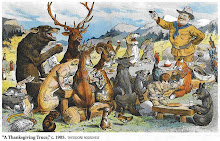Trouble in the Bat World Means Trouble for U.S. Food Supply
Bats deserve better. So say federal and university researchers from the United States and South Africa who have pointed out the economic advantage bats provide in protecting agriculture by eating insects that are harmful to crops—and the potential losses the industry might sustain unless more is done to protect this underappreciated species. Unfortunately, a dangerous fungus has been spreading among America's bat population, causing more than one million to die off, while still others are being wiped out by contact with wind turbines.
A study produced by experts at the U.S. Geological Survey (USGS), the University of Pretoria, University of Tennessee and Boston University shows bats save farmers at least $3 billion a year by eating up insects that otherwise would have to be controlled with chemicals. Paul Cryan, a USGS research scientist and one of the study's authors, said: "This analysis suggests that bats are saving us big bucks by gobbling up insects that eat or damage our crops. It is obviously beneficial that insectivorous bats are patrolling the skies at night above our fields and forests—these bats deserve help."
The fungus, known as white-nose syndrome, causes bats to awaken from hibernation prematurely because they have used up their reserves of body fat. Leaving caves in search of insects that have not yet emerged, the infected bats die during their search for food.
The fungus first appeared in bats in Howe Cave near Albany, New York, in 2006 and since then has spread across the Northeast, to the South and the West. It is now found in 16 states and three Canadian provinces. Two years ago, the U.S. Forest Service temporarily closed down caves in 33 states in an attempt to control the disease. It has also shut down abandoned mines where bats are known to hibernate.
-Noel Brinkerhoff, David Wallechinsky










No comments:
Post a Comment